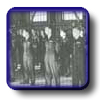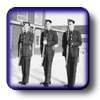A Typical Day
 A
typical day on the base began early, and as soon as the
trainees rose from sleep, procedures were enacted. A good airman
looked after his bunk as though it was his bed at home.
It was made up in regulation fashion and there was absolutely
no excuse for dirty linen as clean sheets could be secured
once a week. The appearance of the barrack room was the
responsibility of all sharing it and men would take turns
cleaning the windows and mopping floors to make sure
it was neat and tidy. A
typical day on the base began early, and as soon as the
trainees rose from sleep, procedures were enacted. A good airman
looked after his bunk as though it was his bed at home.
It was made up in regulation fashion and there was absolutely
no excuse for dirty linen as clean sheets could be secured
once a week. The appearance of the barrack room was the
responsibility of all sharing it and men would take turns
cleaning the windows and mopping floors to make sure
it was neat and tidy.
Breakfast, and all other meals, were received in the mess
hall. Airmen were expected to arrive on time and in appropriate
dress. Airmen ate well. In fact, many trainees from Europe
were shocked to find food in abundance that was rationed at
home. While food availability was not a problem in
Alberta, airmen were reminded not to take more than they
could eat.
 If
an airman was not feeling well, he was to report to his
wing orderly room before breakfast. His name was placed
on a sick report and he continued on to the medical
inspection room. He was examined and given a medical slip determining
if he was to work as usual, perform only light duties, be excused
from duties but confined to barracks, or be detained in hospital
for one day or admitted to the station hospital. Of course
all medical emergencies were handled as they occurred. A
similar procedure was followed if an airman needed dental
work. He would report to the dental clinic and after inspection,
the appropriate treatment was administered. The medical
clinics asked that all men keep track of their health and
accordingly report themselves ill, so that they would be
in good health and prevent any sort of epidemic from spreading
across the station. If
an airman was not feeling well, he was to report to his
wing orderly room before breakfast. His name was placed
on a sick report and he continued on to the medical
inspection room. He was examined and given a medical slip determining
if he was to work as usual, perform only light duties, be excused
from duties but confined to barracks, or be detained in hospital
for one day or admitted to the station hospital. Of course
all medical emergencies were handled as they occurred. A
similar procedure was followed if an airman needed dental
work. He would report to the dental clinic and after inspection,
the appropriate treatment was administered. The medical
clinics asked that all men keep track of their health and
accordingly report themselves ill, so that they would be
in good health and prevent any sort of epidemic from spreading
across the station.
With the exception of lunchtime, at approximately 1200
to 1330 hours, aircrew trainees were involved in a variety
of classes and drills. The specifics of the classes varied
from school to school, but the nature of them remained the
same. An airmen was expected to promptly arrive at the correct
classroom, clean shaven, boots polished and appropriately
dressed in fatigue clothing, ready to receive instruction
on which he would be regularly tested upon. The Royal Canadian
Air Force (RCAF) recognized that different people learned
at different speeds and wanting to graduate as many airmen
as possible, offered extra instruction in the evening for
those who needed it. Discipline was a large part of the
service and trainees were expected to know how to
behave during drills. Without procedures it
would have been nearly impossible for the thousands of men
to have graduated from the British Commonwealth Air Training
Plan (BCATP) in Alberta.
 A
regular evening would find airmen engaged in a wide variety
of activities. Some, such as those learning
night or
instrument flying,
would still be in classes. Others would be studying or receiving
the extra instruction they needed. Airmen who felt comfortable
with what they had learned for the day had the opportunity
for some time off. Many could be found in the station canteens
enjoying a snack, a drink and conversation. As everywhere
else on the station, there were regulations concerning behavior
in the canteen. For example, all food and beverages were
to be consumed before leaving. A handbook outlining all
regulations and procedures pertaining to a specific base
was given to each trainee shortly upon arrival. A
regular evening would find airmen engaged in a wide variety
of activities. Some, such as those learning
night or
instrument flying,
would still be in classes. Others would be studying or receiving
the extra instruction they needed. Airmen who felt comfortable
with what they had learned for the day had the opportunity
for some time off. Many could be found in the station canteens
enjoying a snack, a drink and conversation. As everywhere
else on the station, there were regulations concerning behavior
in the canteen. For example, all food and beverages were
to be consumed before leaving. A handbook outlining all
regulations and procedures pertaining to a specific base
was given to each trainee shortly upon arrival.
A great deal was expected of the airmen on each of the
BCATP bases. The goal of training an air force in such a
short period of time was incredibly ambitious and would
not have been reached without due diligence to the rules
of conduct.


|
 Heritage Community Foundation Presents
Heritage Community Foundation Presents Heritage Community Foundation Presents
Heritage Community Foundation Presents